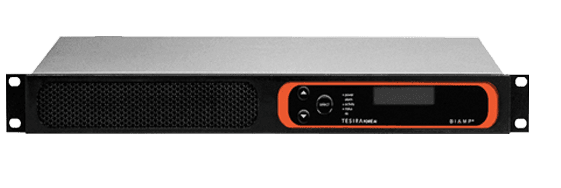If you've ever been on a video call where the audio was echoing, voices were cutting out, or background noise was drowning out the speaker, you know how frustrating poor audio quality can be. While video gets a lot of attention in conference room design, audio is often what makes or breaks the meeting experience.
One piece of technology that can dramatically improve your conference room audio is a Digital Signal Processor, or DSP. But do you actually need one? The answer depends on your room's size, layout, acoustics, and how you plan to use it.
Think of a DSP as the brain of your conference room audio system. It's a specialized computer that processes and optimizes audio signals in real-time, performing sophisticated tasks that basic hardware simply can't handle on its own.
Here's what a DSP does behind the scenes to make your meetings sound professional:
Acoustic Echo Cancellation (AEC) stops remote participants from hearing a distracting echo of their own voices. This is especially important when you have multiple microphones and speakers in the room, which can create feedback loops.
Noise Reduction digitally filters out those annoying background sounds like air conditioning hum, keyboard typing, or traffic noise from outside, making speech clearer and more intelligible.
Automatic Gain Control (AGC) ensures everyone sounds consistent, whether they're speaking softly or projecting their voice across the room. It also compensates for how far someone is from the nearest microphone.
Automatic Mixing intelligently activates the microphone closest to whoever is speaking while muting the others. This reduces ambient noise and keeps the focus on the active speaker.
Signal Routing and Mixing manages the complex flow of audio from multiple sources—microphones, laptops, remote participants—to various destinations like speakers, recording devices, and video conferencing platforms.
Equalization (EQ) adjusts the audio frequencies to compensate for challenging room acoustics, making voices sound more natural instead of tinny or muffled.
Delay Compensation synchronizes audio and video, preventing those awkward lip-sync issues that happen when video processing introduces slight delays.

A dedicated DSP becomes essential in conference rooms with these characteristics:
Medium to Large Rooms: Once you move beyond a small huddle space, participants get too far from a single microphone to be heard clearly. A DSP ensures everyone is captured with consistent quality.
Multiple Microphones or Speakers: If your setup includes ceiling microphones, table mics, or separate speaker systems, you need a DSP to manage and combine these audio streams seamlessly.
Challenging Acoustics: Rooms with lots of glass, tile, concrete, or other hard surfaces create echoes and reverberation. Rather than investing in expensive acoustic panels or treatments, a DSP can electronically correct many of these issues.
High-Stakes Meetings: When your conference room hosts executive meetings, client presentations, board meetings, or other critical events, professional-quality audio isn't optional. Poor sound quality damages credibility and productivity.
Flexible or Divisible Spaces: If your room can be split or combined with adjacent spaces, a DSP is necessary to intelligently route audio based on the current configuration.
Not every conference room requires a dedicated DSP. Here are situations where you can go without one:
Small Huddle Spaces: Modern all-in-one conference bars like the Logitech Rally Bar come with built-in microphones, speakers, and integrated DSP processing. For rooms accommodating just a few people, these devices provide everything you need.
Very Basic Setups: If you're using a single USB microphone and simple speaker, your computer or video conferencing software may provide adequate basic audio processing for casual meetings.
Dante-Enabled Microphones: Some advanced microphones from manufacturers like Shure include built-in DSP capabilities such as beamforming. For simpler distributed setups, these may be sufficient on their own.
A dedicated DSP is a strategic investment that transforms your conference room from having just "audio equipment" to having a truly professional communication system. While small spaces can get by with integrated solutions, any conference room designed for serious collaboration benefits tremendously from dedicated audio processing.
Clear, intelligible audio isn't a luxury—it's the foundation of effective communication. If your conference room is important enough to outfit with video technology, it's important enough to get the audio right. For most professional spaces, that means including a DSP in your design.
Your remote participants will thank you for it.
